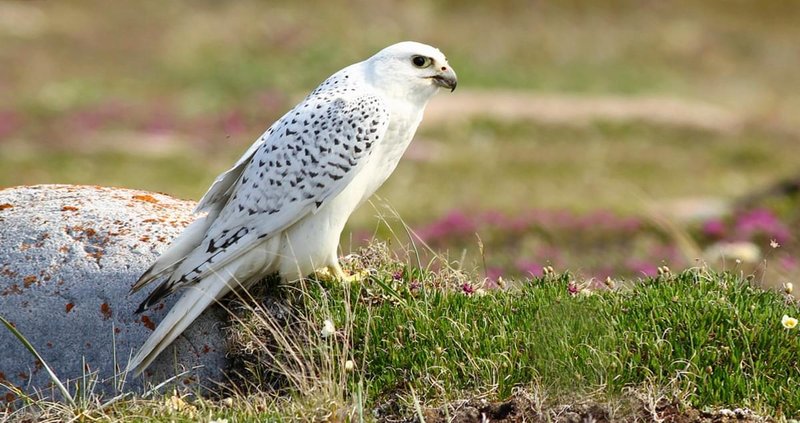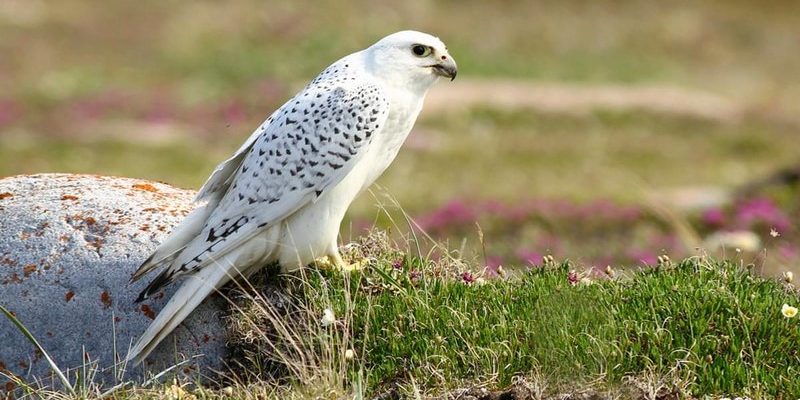
Gyrfalcons are often found in the icy realms of the Arctic and sub-Arctic regions, where they thrive in some of the most challenging environments on Earth. These birds are not just beautiful; they also possess some remarkable adaptations that allow them to excel in their harsh habitats. Let’s dive into ten fascinating tidbits about the gyrfalcon that might surprise you and broaden your appreciation for this incredible bird.
1. A Regal Appearance with Varied Plumage
One thing that sets the gyrfalcon apart from its smaller relatives is its size and plumage. Gyrfalcons come in a variety of colors ranging from white to dark gray, with some even displaying mottled patterns. This range is not just for show; it serves a functional purpose. The lighter-colored gyrfalcons, often referred to as “white morphs,” blend seamlessly into their snowy surroundings, making them excellent hunters.
You might be wondering how this variation occurs. It’s primarily due to geographic differences and habitat. In areas with harsher winters, you’re more likely to spot these stunning white morphs, while darker variations are more common in regions with less snow. This diversity in coloration helps them adapt to their specific environments and hunting conditions.
2. The Gyrfalcon’s Incredible Speed
If you think all falcons are fast, wait until you hear about the gyrfalcon’s speed. These birds have been clocked flying at speeds over 55 miles per hour during level flight! That’s fast enough to catch most small animals they hunt. In fact, their hunting skills are legendary; they can take down prey much larger than themselves—like hares and even ducks.
Speed is essential for survival, especially in the Arctic, where food can be scarce. Gyrfalcons often rely on their speed and agility to outmaneuver their prey. They can dive, twist, and turn with astonishing grace, making them formidable predators. Imagine trying to escape from a creature that can swoop down on you at such high speeds—it’s a true testament to nature’s design.
3. An Apex Predator with Unique Hunting Techniques
Here’s the thing about gyrfalcons: they don’t just rely on brute force to catch their food. They have developed unique hunting techniques that allow them to adapt to the Arctic ecosystem. One common strategy is to perch high on cliffs or tall trees, where they have a clear view of the ground below. This high vantage point enables them to spot potential prey from a great distance.
Once they identify their target, they make a calculated dive, often using the element of surprise. They can also engage in aerial chases, showcasing their unmatched agility. Their preferred prey includes small mammals and birds, but they won’t shy away from larger targets when food is scarce. Imagine being able to scan your surroundings from high above, pinpointing your dinner with laser focus—it’s quite an impressive skill.
4. A Strong Bond with Their Partners
Gyrfalcons are known for their strong pair bonds. Once they find a mate, they typically stay together for life. This long-term partnership is vital for their survival, as both parents play a role in raising their young. They take turns hunting and caring for the nest, ensuring the safety and well-being of their chicks.
During the breeding season, you might see these birds engaging in courtship displays, which include impressive aerial acrobatics and vocalizations. This display not only strengthens their bond but also establishes territory, as they communicate their readiness to defend their space from rivals. It’s like a dramatic dance show in the sky, showcasing both beauty and skill.
5. Nesting in Extreme Environments
You might be surprised to learn that gyrfalcons have a unique approach to nesting. Unlike many birds that build elaborate nests, gyrfalcons often choose cliffs, ledges, or existing scrapes in the rock to lay their eggs. This method is practical—by nesting in such remote places, they reduce the risk of predators disturbing their young.
Their nests can be quite minimal, consisting of just a few well-placed feathers and some stones. However, once the eggs are laid, both parents are highly protective and will fiercely guard their chicks from any potential threats. Imagine living in a cozy but exposed home on the edge of a cliff, with the whole world watching—you’d want to keep your little ones safe too!
6. A Versatile Diet
The gyrfalcon is not a picky eater. Its diet consists of various prey, which often changes depending on the season and availability of food. While they primarily hunt birds and small mammals, they have been known to eat everything from rabbits to seabirds. This versatility is crucial in the unpredictable Arctic environment, where food sources can fluctuate dramatically.
Interestingly, they also exhibit a behavior known as *food caching*. This means they’ll store extra food when there’s plenty available, saving it for times when hunting becomes difficult. It’s a smart survival tactic that helps them thrive in a habitat where conditions can change overnight.
7. Conservation Status and Challenges
Despite being impressive creatures, gyrfalcons face several challenges in the wild. Although they’re currently listed as “Least Concern” by the IUCN, their populations can be impacted by environmental changes, habitat destruction, and climate change. As the Arctic warms, the conditions that make their habitat suitable may shift, affecting their hunting grounds and nesting sites.
Conservation efforts are underway to monitor and protect these majestic birds. Organizations work tirelessly to study their habits and ensure that they continue to thrive in their natural environments. Understanding these challenges is crucial if we want to help preserve the species for future generations.
8. The Gyrfalcon in Culture and History
Throughout history, gyrfalcons have captivated human imagination. They’ve been featured in art, literature, and even used in falconry by nobility. In medieval times, owning a gyrfalcon was a status symbol, reserved for the elite who could afford to keep and train such magnificent birds. This rich history adds another layer of fascination to their already impressive profile.
Today, gyrfalcons continue to inspire birdwatchers and nature enthusiasts around the world. Their beauty and strength symbolize the wild, untamed spirit of the Arctic. They remind us of the delicate balance between nature and the challenges of modern life.
9. Remarkable Adaptations to Cold Climates
Living in some of the coldest areas on Earth, gyrfalcons have developed several adaptations to help them survive frigid temperatures. One of the most fascinating adaptations is their thick plumage, which insulates them against the biting cold. They also have a unique feather structure that helps trap heat, allowing them to maintain their body temperature in such harsh environments.
Additionally, their strong feet and sharp talons are designed to grip onto ice and rocky surfaces, providing stability when hunting or nesting. You might think of them as nature’s example of resilience, perfectly equipped to thrive against the odds in some of the toughest climates on the planet.
10. The Gyrfalcon’s Role in Ecosystems
Lastly, we can’t overlook the gyrfalcon’s role in maintaining the balance of their ecosystem. As apex predators, they help regulate the populations of small mammals and birds, ensuring that the ecosystem remains healthy. By controlling these populations, gyrfalcons contribute to the overall biodiversity of their habitat.
Their presence is an indicator of a healthy environment. If gyrfalcon populations decline, it often signals broader environmental issues that may need addressing. Conservationists keep a close eye on these magnificent birds because they play an essential role in the ecosystem’s balance.
In conclusion, the gyrfalcon is more than just a beautiful bird; it’s a symbol of adaptability and strength in one of the most challenging climates on Earth. From their regal appearance and impressive hunting skills to their cultural significance and ecological roles, there’s so much to appreciate about these extraordinary creatures. By understanding and protecting them, we can help ensure that their legacy continues for years to come.

